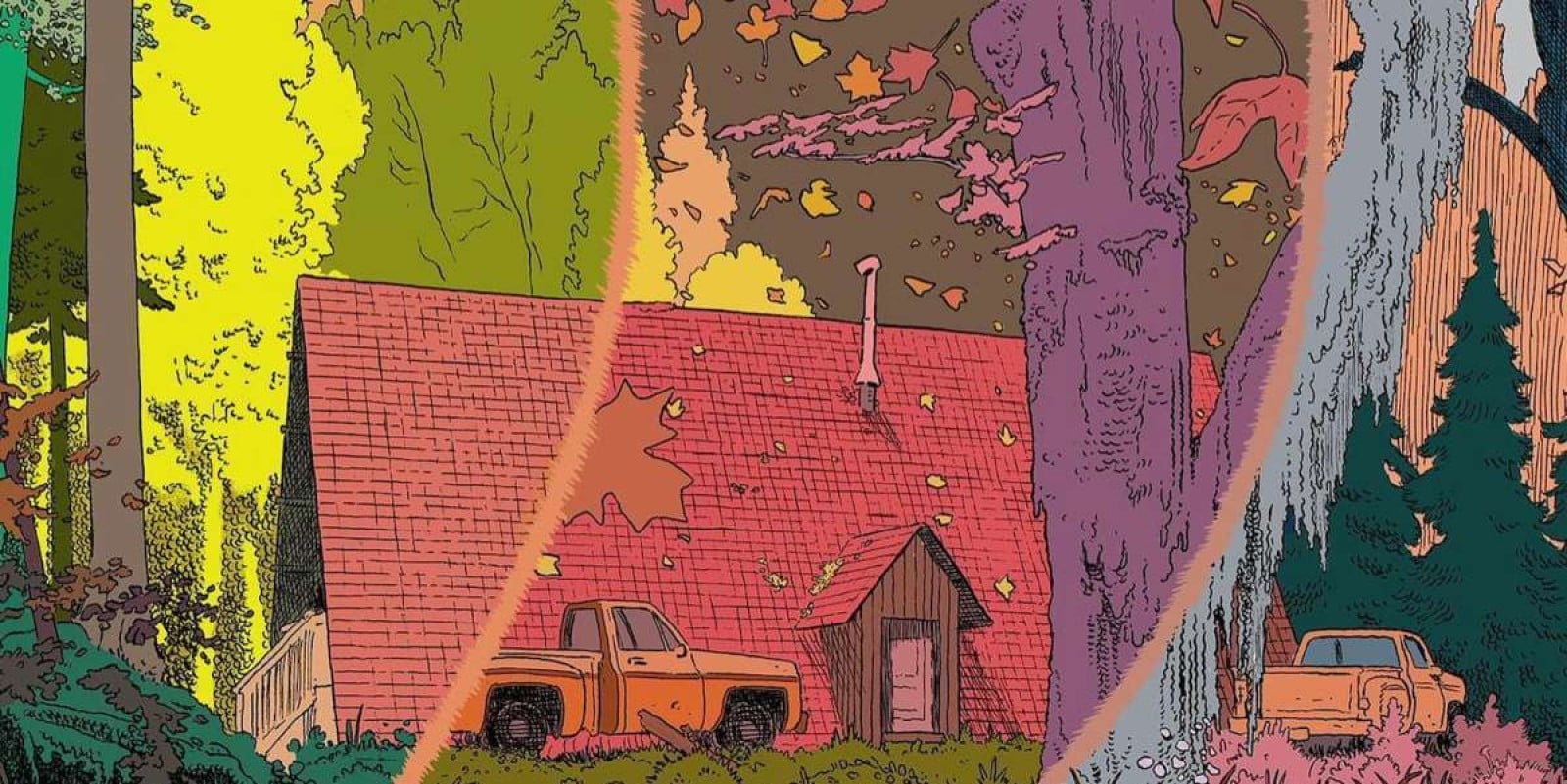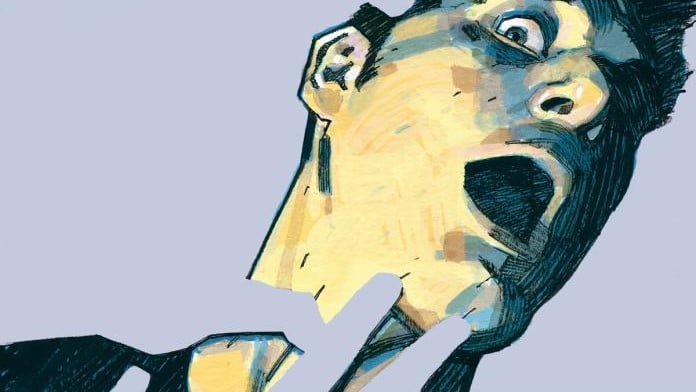Wherever Alex Paknadel’s name shows up, deeply engaging and strange comics are sure to follow. TKO Studios’ Roofstompers, despite its brevity, is no different. Paknadel is joined by artist Ian MacEwan and letterer Hassan Otsmane-Elhaou for a stunning and twisted take on a time-traveling tale whose scope opens at such a steady pace it’s hard for the reader to tell they’ve fallen in until it’s too late.
A somewhat brief synopsis: Carrie, getting away from a fatal mistake as a surgeon, goes on a hunting trip and is attacked by a bear. A strange couple take her in to heal over the course of a few weeks, and from then on things get weird as they are visited by the mysterious “roofstompers.” Things only continue to get stranger as the book dives into horror, science fiction and back again, keeping the reader on their toes as the story speeds toward a cathartic conclusion.
As I said, the scope of this short comic is incredible. So many ideas get added to this soup but are fed in such a way that it’s difficult to feel overwhelmed until things start getting fully laid out. Paknadel and MacEwan create a sense of unease following Carrie’s rescue/abduction and in the six or seven pages of playing with the mystery give just enough peaks through the window at what’s going on to never show the full picture, just enough to get a sense that whatever is behind the curtain is very strange.
And truly every element builds that tension, especially the visuals. MacEwan’s use of textures gives a sense of static throughout the story, like what we are witnessing is in between the channels on a TV. The lack of ink spotting for shadows is also such an effective choice when it comes to giving them a sense of movement, which feels sound in this story focused on so many unknowns and uncertainties. Another incredible choice on top of MacEwan’s textures are his colors. The muted pinks and greens sell such an unnatural feeling. It could be easy for those colors to get saturated or flashy, but saturation is reserved for very particular and affecting moments. However, the colors at play compliment each other well despite eschewing realism as the story unravels for a more striking combination. Although the later uses of these colors and techniques sell fear, MacEwan also is able to depict absolutely gorgeous and imposing backdrops of nature and the cabin that juxtapose the unsettling events that occur.

Roofstompers also has the pleasure of being lettered by one of the best in the biz, Hassan Otsmane-Elhaou. Otsmane-Elhaou crafts an extremely specific look for dialogue in this comic. The first choice that made me specifically go “oooh!” was the way the balloons on the other end of Carrie’s phone call looked. While it took me a second glance to understand what that was, the choice to mirror the tiny digital squiggles on the edge of the balloon onto the tail was something I had never seen before and was a great way to let this digital sound feel at home in the very analog-feeling curvy and sinuous balloons and tails throughout the rest. And that’s only the first of many moments of intrigue Otsmane-Elhaou pulls off in this book. If I went into them all, this piece would be double its length.
While so much of this short is sold on its presentation, Paknadel’s story is not without merit. As mentioned before, the pacing (which may be more to do with MacEwan’s layouts) is maybe what Roofstompers does best. The mystery, the what the hell is this is all just so uniquely strange and impressively pulled off that it’s worth the $2.99. However, the bones start to shake a little bit once the curtain lifts to show the whole picture. A lot is thrown at the reader in the final seven pages, and it is hard to keep track of for folks who want to walk away with the bare beats of the story (say, a reviewer for a comics website). We are introduced to a new messed up use of a classic science fiction trope, a lot of deceit and paradoxes by the end, but I still don’t really remember why Carrie was being kept by this couple. And while this influx of plot elements can feel overwhelming, the pacing of the story still holds up, and the thematic conclusion remains satisfying.
On the base level, “the mad science being punished for reaching for too much power” is always going to be a satisfying beat to end on, but Paknadel adds so many thematic throughlines that give it just a little bit more resonance. The idea of the unending cycle is something that has had a lot of resonance lately in pop culture, and having it implemented here in such an unsettling horror framework is really appealing and even more satisfying to see broken. There’s also something about one of the characters’ lines about the roofstompers’ eyes at the end, which really stands out due to the weight they carry in the plot. As much as it might feel like the plot balloons, the thematic resonance and catharsis of the finale can’t be denied.
Ultimately the team of Roofstompers told a genuinely harrowing and intriguing story with a slowly widening scope in the course of 17 pages with incredibly well thought out pacing and visual language. The biggest flaw I can accuse it of is ambition, which is hard to follow through on when it succeeds on so many levels. Roofstompers is an incredibly weird and affecting sci-fi horror story that takes its time telling you where it’s going and leaves you dazzled and stranded once you get there.
Kenneth Laster is a critic, cartoonist, and cryptid with a movie degree.



